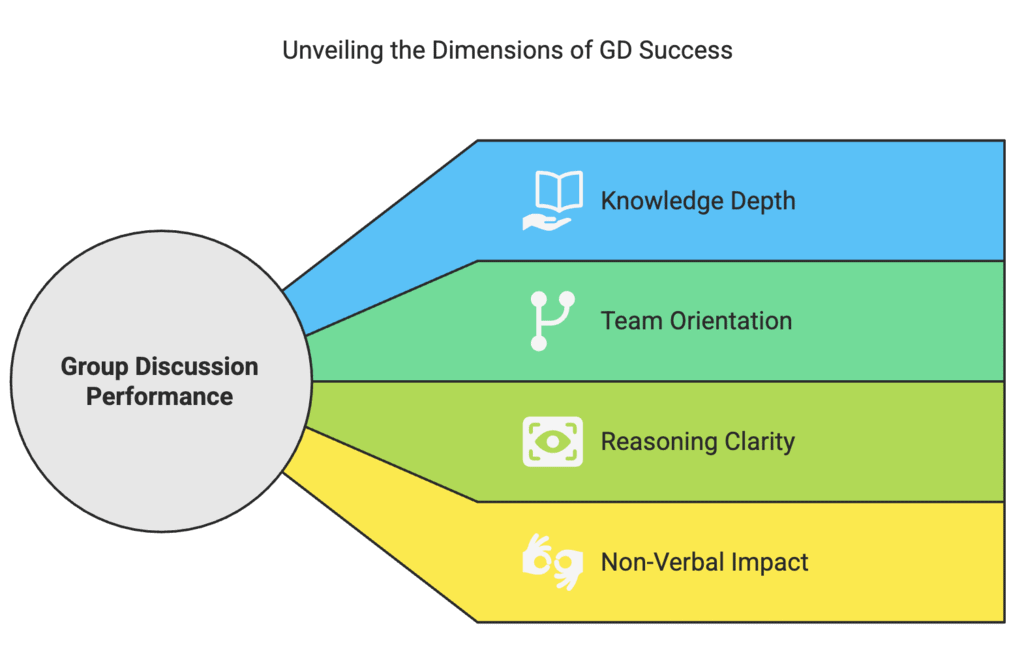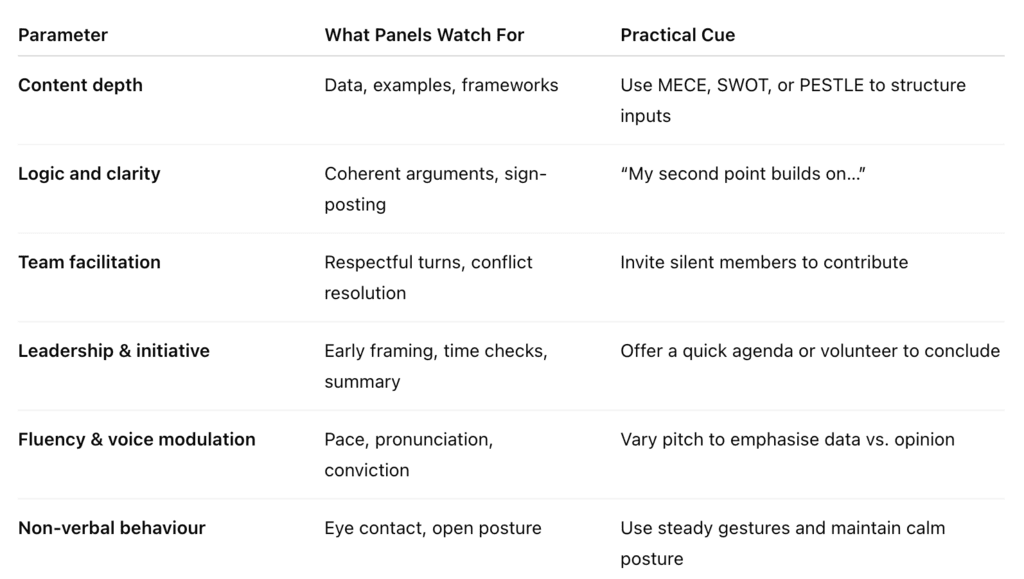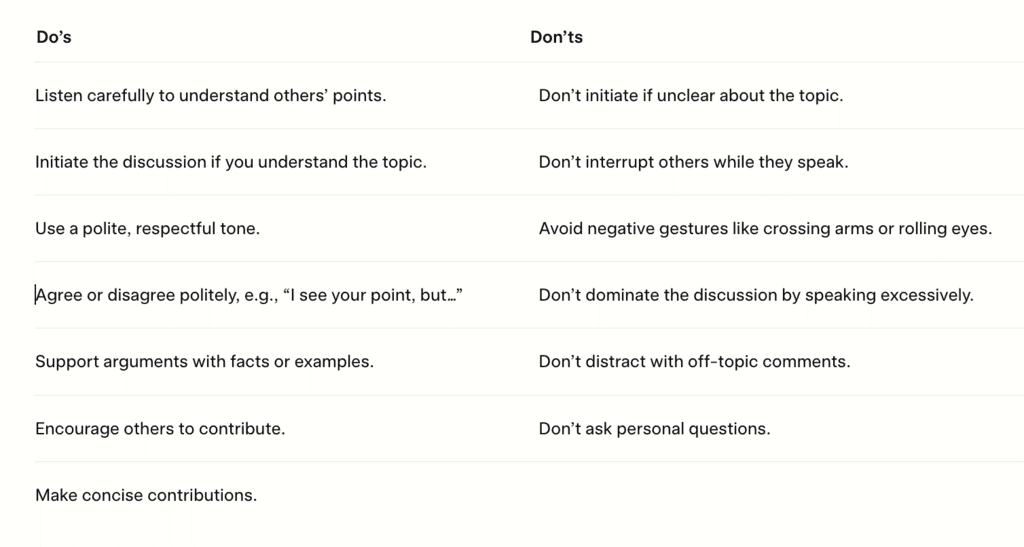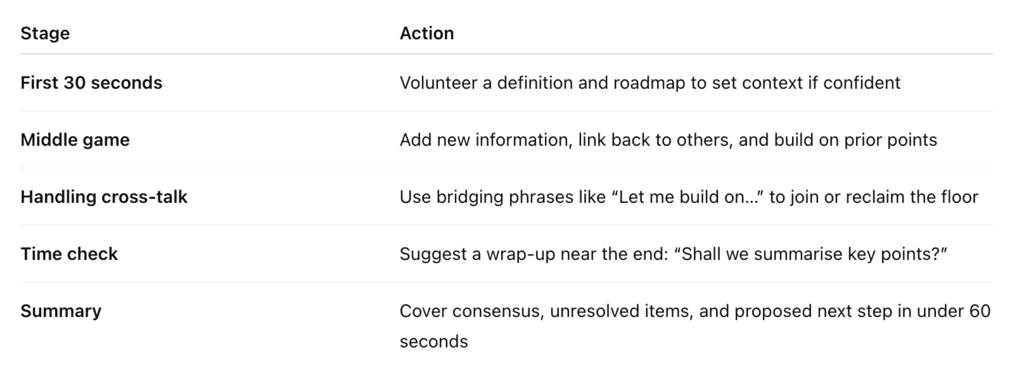GD: Overview, Preparation and Topics | CAT Interview Preparation Guide PDF Download
Group discussions (GDs) continue to be a decisive filter in B-school admissions and campus hiring because they reveal a participant’s knowledge depth, team orientation, reasoning clarity, and non-verbal impact in just 15–20 minutes. Recruiters reward candidates who
- arrive with well-organised ideas
- listen as actively as they speak
- steer the group toward a consensus without dominating it.
This explains what to expect, how you will be scored, and the exact habits that separate final-round qualifiers from the rest.

What Is a Group Discussion?
A group discussion is a timed conversation—usually 8–12 participants, 15–25 minutes—conducted to test collaboration and decision-making under gentle time pressure.
Unlike a personal interview, the GD checks how you co-create ideas, handle disagreement, and build on others’ points—capabilities that influence real-world teamwork.
Why B-schools and Employers Insist on GDs
Holistic skill audit: Content mastery, logic, delivery, empathy, persuasion, poise.
Predictor of leadership potential: Candidates who can frame problems and synthesise viewpoints often repeat that behaviour in professional settings.
Efficiency: A single GD gives assessors more behavioural data per minute than a series of one-to-one interviews.
Key Qualities to Demonstrate in GD
To excel in a GD, candidates must showcase a range of skills that reflect their potential as effective communicators and leaders. Below are the key qualities to focus on, with practical ways to demonstrate them:
Presentation
- Effective presentation sets the tone for your contributions. Start with a concise introduction to the topic, such as, “Digital transformation is reshaping industries by enhancing efficiency, but it also raises concerns about data privacy.”
- Structure your points logically, using transitions like, “While this is a benefit, we must also consider…” to maintain coherence. Support arguments with examples or data, such as citing the growth of e-commerce during the pandemic.
- Practice in mock GDs to refine delivery and ensure smooth transitions, as suggested by Indeed.
Subject Knowledge
- A strong grasp of diverse topics is essential. Stay informed about current affairs, economic trends, social issues, and controversial subjects like gender equality or privatisation.
- Read newspapers like The Times of India or The Hindu, and magazines like The Week or Frontline for in-depth analysis.
- Engage in online forums like Reddit to gain diverse perspectives.
- For example, knowing recent policy changes or technological advancements can help you contribute meaningfully.
Expression Clarity
- Clear expression ensures your ideas are understood. Speak concisely, avoiding slang, and use a cheerful tone with proper modulation. For instance, instead of saying, “Education is bad because of many issues,” say, “The education system faces challenges like inadequate funding and outdated curricula.”
- Practice speaking aloud or recording yourself to improve fluency and maintain eye contact to engage listeners, as recommended by Emeritus.
Managerial Qualities
Self-confidence: Speak with assurance and take initiative when appropriate. Practice in group settings to build confidence.
Decision-making ability: Summarise discussions or propose solutions, showing analytical skills.
Assertiveness: Express opinions firmly but respectfully, e.g., “I see your point, but I believe…”
Emotional stability: Stay calm, even in heated discussions, to demonstrate professionalism.
Logical thinking: Present arguments in a structured manner, supported by evidence.
Democratic approach: Encourage quieter participants to contribute, fostering inclusivity.
Communication Skills
- Effective communication includes verbal and non-verbal elements.
- Use clear, concise language and avoid grammatical errors. Maintain open body language, such as sitting straight and making eye contact.
- Active listening is crucial—nod in agreement or paraphrase others’ points, like, “I understand your view on sustainability, and I’d add that…” This shows engagement and respect.
Good Listening
- Good listening involves patience and attentiveness.
- Avoid interrupting and take mental notes to respond thoughtfully.
- For example, if someone discusses economic growth, you might say, “Building on your point, I think infrastructure investment is key.” This demonstrates respect and enhances group dynamics.
Time Management
- Manage your speaking time to allow others to contribute.
- Be concise and help guide the discussion toward a conclusion, such as, “We’ve covered several points; let’s summarise the key takeaways.” This ensures the discussion stays on track within the time limit.
How You Will Be Evaluated
Panels often use a weighted scorecard that balances individual excellence and group synergy.

Do’s and Don’ts in GD

Preparation Road-map
Strengthen Core Knowledge
Daily 30-minute news sprint: Read one business, one tech, and one policy source; summarise in personal notes.
Theme briefing sheets: For major issues, maintain a one-page dossier with facts, pros, cons, national and global angles, and recent developments.
Mock GD circles: Weekly 20-minute sessions with peers; rotate roles like initiator, devil’s advocate, and summariser.
Sharpen Communication
Record a 90-second elevator pitch on your phone and fix common fillers.
Practise three-point structuring—intro, body, summary—to avoid rambling.
Read editorials aloud to improve diction and pacing.
Rehearse Body Language
Neutral-open posture: Feet grounded, shoulders back, hands above the table.
Engagement nods: Nodding while others speak shows active listening.
Mirroring: Subtly match group energy to build rapport.
Winning Tactics Inside the GD

Major Types of GD Topics
Current Affairs
- Importance of the Statue of Unity
- Citizenship Amendment Act - What and Why
- How will the Abrogation of Article 370 improve the situation in Kashmir
- Is it still too early for India to have bullet trains?
- Making Aadhaar mandatory is not a good idea- for or against
- Implications of CAA-NCR
Business and Economy
- Will reduced Goods & Services Tax (GST) help the Indian economy grow faster?
- Cashless Economy – Is India ready for it?
- How can we control banking frauds to reduce NPAs?
- Make in India campaign
- Demonetization: Discuss its Success & failures
- Statue of Unity - Symbol of Pride or Wastage of Public Money?
Social Issues
- Success of Swachh Bharat Mission
- Rural vs Urban India
- Environment and us
Abstract Topics
- Self-Motivation
- First impression is the last impression
- Friends, Enemy or Frenemies?
- Ethics or Profit?
Common Pitfalls to Dodge
Speaking in long, unstructured paragraphs that confuse listeners
Dominating the discussion or cutting others off
Agreeing too easily without critical engagement
Fidgeting, crossing arms, or showing nervous energy through gestures
|
21 videos|18 docs
|
FAQs on GD: Overview, Preparation and Topics - CAT Interview Preparation Guide
| 1. What is the purpose of a group discussion (GD)? |  |
| 2. How are participants evaluated during a group discussion? |  |
| 3. What preparation strategies can help improve performance in a group discussion? |  |
| 4. What are some common types of topics discussed in group discussions? |  |
| 5. What are some common mistakes to avoid during a group discussion? |  |
















